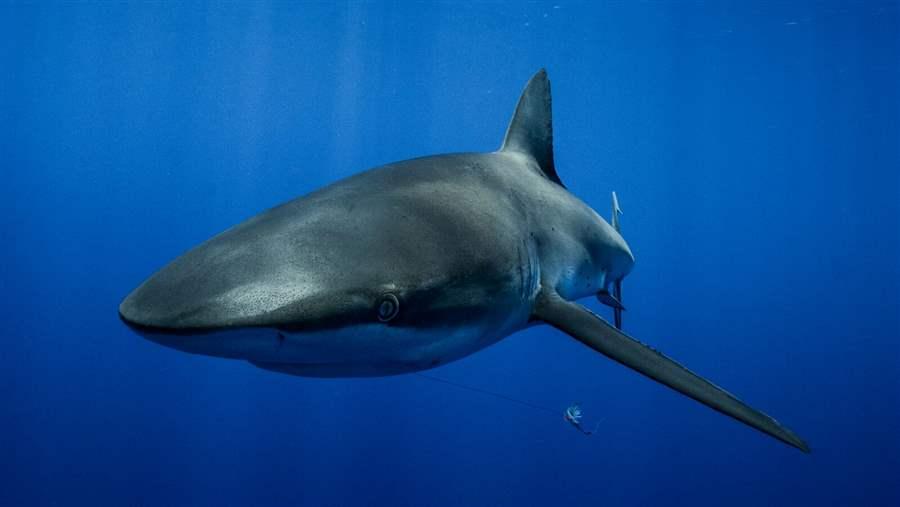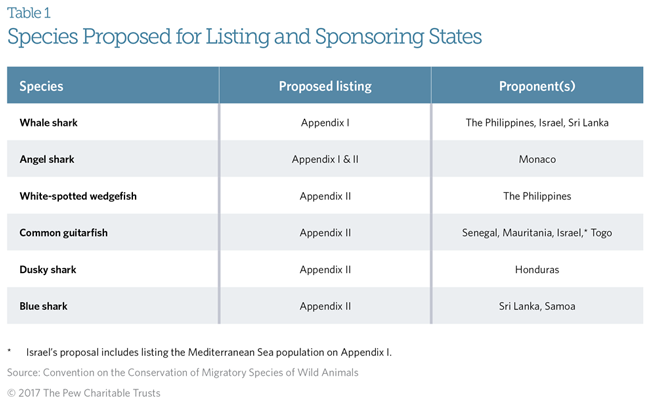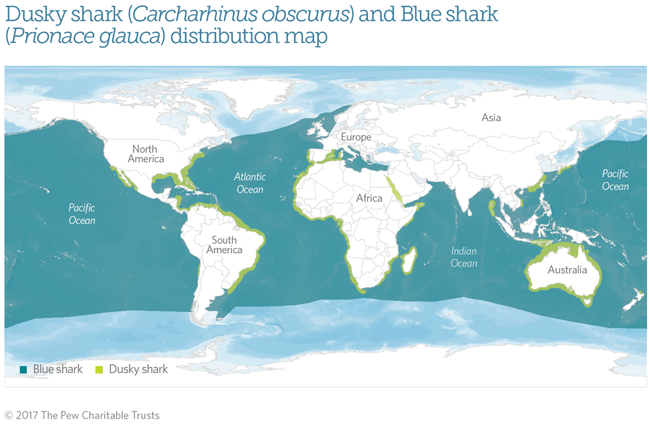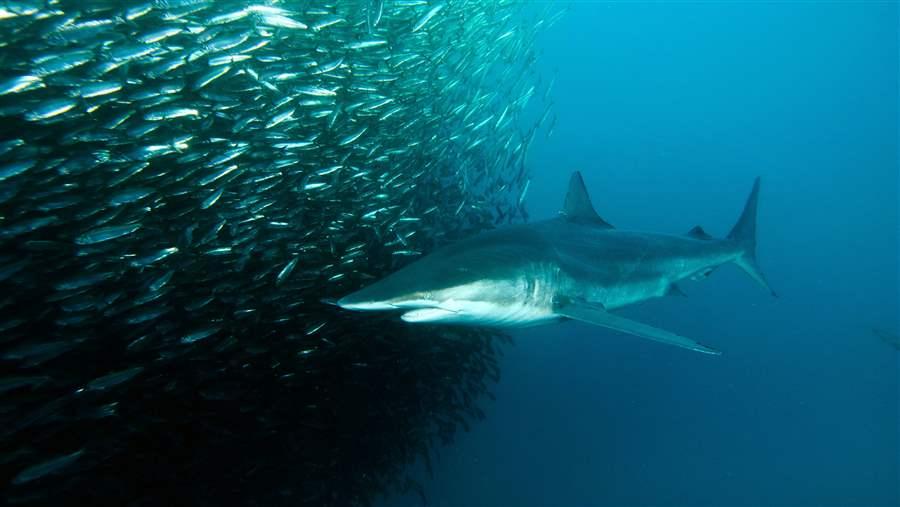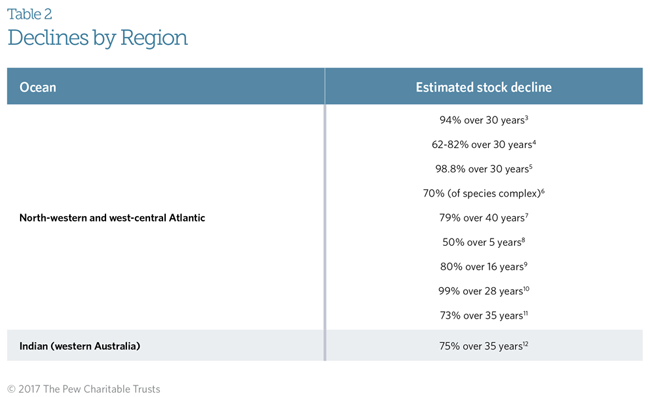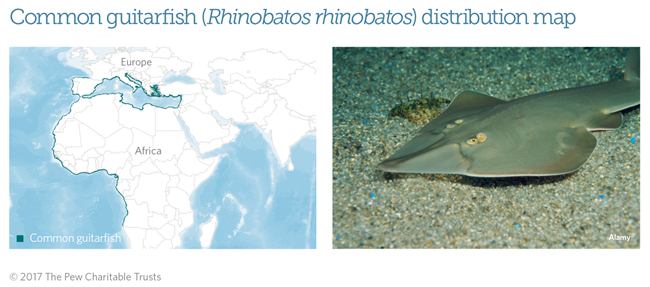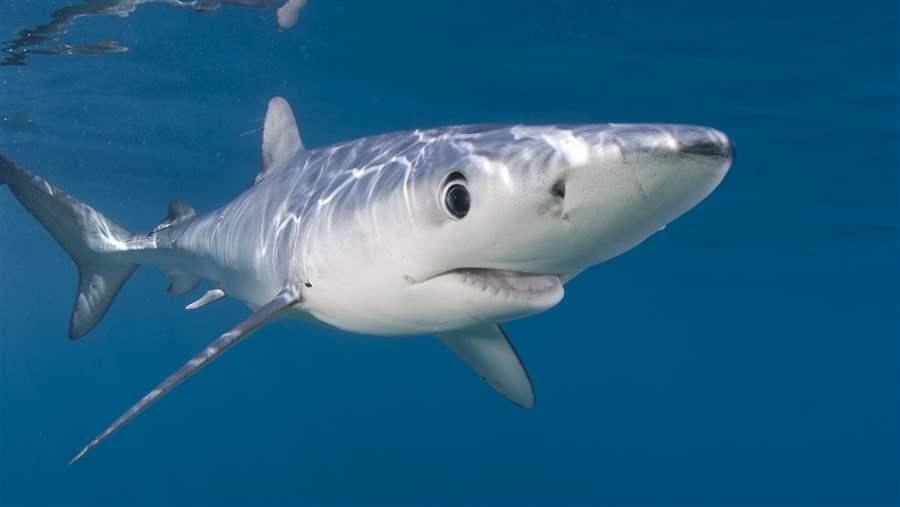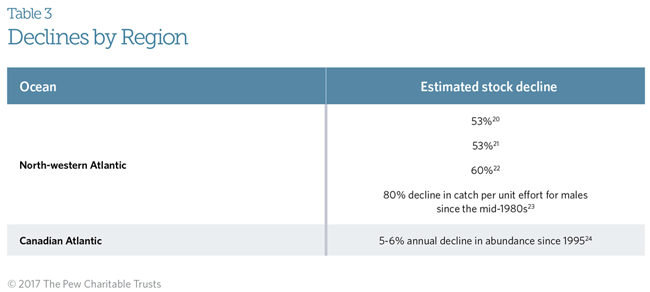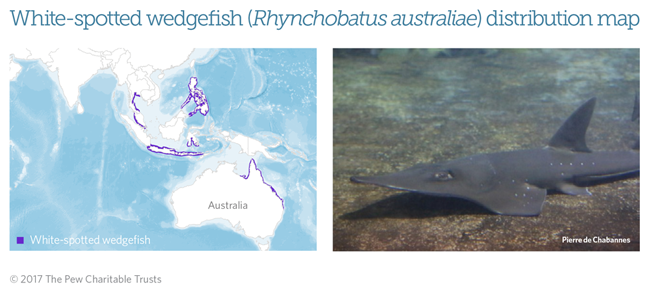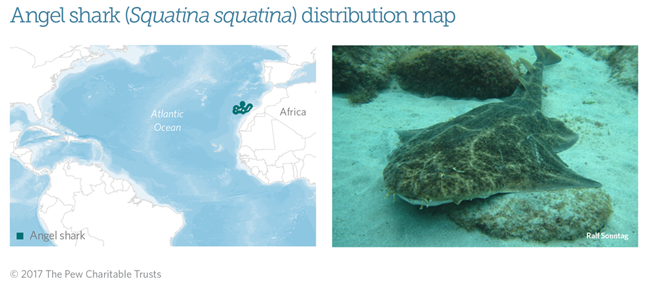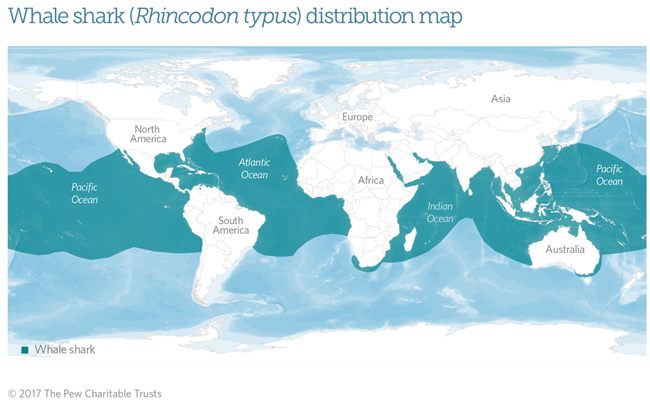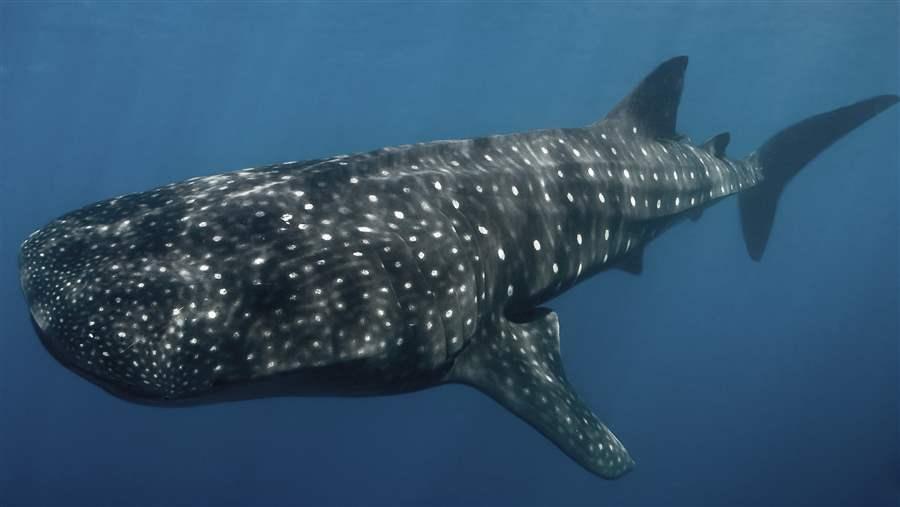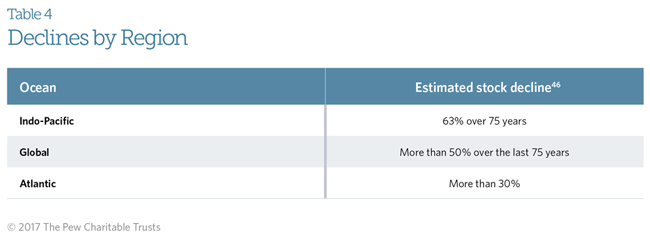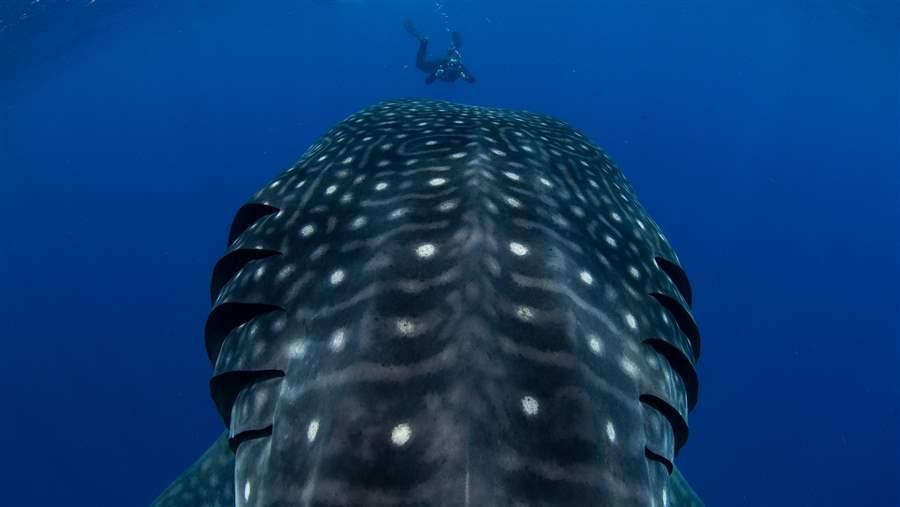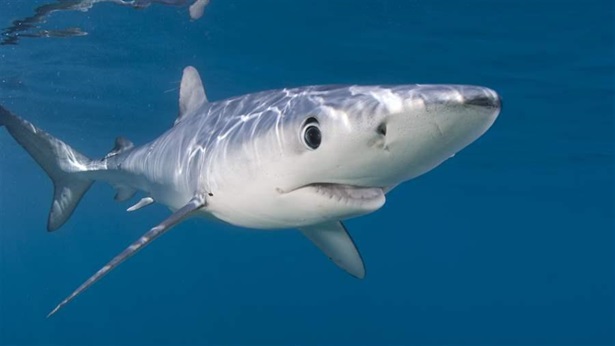Protections for Threatened Migratory Sharks
Convention on the Conservation of Migratory Species’ 12th meeting of the Conference of the Parties
Overview
Protecting migratory marine species and their habitats is a critical component of efforts to ensure the health of the world's oceans. One of the biggest challenges facing the seas is the depletion of its top predators. Each year, 63 million to 273 million sharks1 are killed, far more than these species can endure. The demand for their fins, meat, liver oil, and other products coupled with this unsustainable fishing rate has driven declines in shark populations worldwide. The International Union for Conservation of Nature estimates that more than half of shark and ray species are Threatened or Near Threatened with extinction. Whether this catch is unintended, unwanted, or highly sought after, the effect on ocean ecosystems requires urgent action.
With its focus on conserving migratory wildlife, the Convention on the Conservation of Migratory Species of Wild Animals (CMS) plays a key role in this effort. CMS has helped to protect the world's sharks through the listing of 29 species and the establishment of a dedicated memorandum of understanding. For the 12th meeting of the Conference of the Parties to CMS (COP12) in Manila, the Philippines, governments have proposed a range of Appendix I and II listings. An Appendix I listing mandates full protection of those species most at risk, and an Appendix II listing ensures that the species is recognized as a global conservation priority.
Species threatened by the fin trade
The fin trade remains one of the major drivers of global shark declines. In recent years, several regularly traded species have gained protections through the Convention on International Trade in Endangered Species of Wild Fauna and Flora (CITES), but many have been left unprotected and have few restrictions on their global commerce.
Blue and dusky sharks, caught and traded for their high-value fins and increasingly for their meat, are urgently in need of better management. A CMS listing can help make sustainable fishing practices a priority by encouraging international action through regional fisheries management organizations (RFMOs), domestic regulations, or additional CITES listings.
Profile: Dusky shark (Carcharhinus obscurus)
Proposed for Appendix II listing by Honduras Recommended for inclusion by CMS Scientific Council
Dusky sharks are a large, highly migratory coastal and occasionally pelagic species found in tropical, subtropical, and temperate seas. Dusky sharks migrate seasonally to remain in warmer waters, moving both between States' exclusive economic zones (EEZs) and from EEZs into the high seas.
The dusky shark has only two to 16 pups after a two-year pregnancy.2
They are one of the least productive and most vulnerable of all shark species, giving birth to pups every two or three years. They also have low intrinsic growth rates, making them highly susceptible to overfishing (whether as target or bycatch).
IUCN status
The dusky shark is listed on the International Union for Conservation of Nature's Red List of Threatened Species as Vulnerable to extinction globally, due to sharp declines in its population worldwide.13 Regionally, the dusky shark was found to be Endangered in the north-western and west-central Atlantic Ocean, Vulnerable in the south-western Atlantic, and Data Deficient in the Mediterranean Sea and north-eastern Atlantic.14
Population threats
Unsustainable fishing is the greatest threat to this species, whether by targeted fisheries supplying dusky shark meat and fins for international trade, or by fisheries for other species retaining it as bycatch. Dusky shark fins accounted for about 1.4 percent of sharks sold in Hong Kong in the early 2000s, equating to 144,000 to 767,000 individuals per year.15
A 2016 stock assessment estimates that overfishing has caused a 73 percent decline in dusky sharks and that it will take decades for the species to recover.16
Management gaps
Although some countries, such as the United States and Australia, have set catch limits for dusky sharks, there are no international management measures in place to combat their steady decline. This lack of focus on the species by high seas regional fisheries management organizations is primarily due to their coastal, rather than pelagic, nature, but there has been a similar lack of action from range States and coastal regional fisheries bodies, and the species is not listed under CITES.
The 2007 "Review of Migratory Chondrichthyan Fishes" by the IUCN's Shark Specialist Group and CMS noted:
A CMS Appendix II listing could help to drive the improvements in national and regional management that are required if this species is to recover from depletion and become managed sustainably. Indeed, the species is so very vulnerable to overexploitation that it may qualify for an Appendix I listing, at least in parts of its range.17
Dusky sharks urgently need to be conserved wherever they are found, due to their particularly low reproductive rate; their significant population declines; the high demand for their fins, meat, and other parts; and the lack of regulation or protection across most of their range.
Profile: Blue shark (Prionace glauca)
Proposed for Appendix II listing by Sri Lanka and Samoa Recommended for inclusion by CMS Scientific Council
The blue shark is a highly migratory species found in tropical, subtropical, and warm-temperate waters around the globe, both on the high seas and within EEZs.
These sharks take up to seven years to mature and can have up to 68 pups per litter.18 Their reproductive rate is higher than that of many shark species, but an estimated 20 million19 blue sharks are killed annually and their populations are declining globally. Blue sharks dominate the shark fin trade, and landings worldwide have nearly tripled since 2000. Without global cooperation, the lack of management for blue sharks and extensive targeting by fisheries place them at great risk of extinction.
An estimated 20 million blue sharks are killed every year.
Despite huge catches, this species is unmanaged by the world's RFMOs.
IUCN status
The blue shark is considered Near Threatened globally and Critically Endangered in the Mediterranean.25
Population threats
The species is caught in extensive, targeted fisheries on the high seas and is bycatch in other pelagic fisheries throughout its range. Blue sharks' proportion of all shark landings tripled from 1998 to 2011-from 4 to 14 percent.26
The world's most traded shark-valued for its fins in Asia and meat in Europe.27
Management gaps
There are no fisheries management measures-or international trade regulations-for blue sharks that extend throughout their range, so populations of this highly migratory species are likely to continue to decline until globally applicable, enforceable measures are introduced to prevent overexploitation.
None of the major RFMOs has adopted catch or bycatch limits for this species. Scientists with the International Commission for the Conservation of Atlantic Tunas have repeatedly recommended capping Atlantic blue shark catches, particularly in the South Atlantic, where it is at higher risk, but no action has been taken.
Despite its status as the most-caught shark, P. glauca is not listed under CITES.
The 2007 "Review of Migratory Chondrichthyan Fishes" by the IUCN and CMS noted:
There is no disagreement ... over the urgency of introducing management for this species; unfortunately no large-scale collaborative/regional management actions currently seem likely, other than those delivered through shark finning bans. The blue shark is certainly in urgent need of collaborative management by range States and through regional fisheries bodies, but appears not to be a high priority for action at the present time. A CMS Appendix II listing could help to drive the improvements in national and regional management that are required if this species is to be managed sustainably.28
Flattened sharks disappearing fast
Guitarfish, wedgefish, and angel sharks-known for their flattened bodies-have been identified as three of the shark families with the highest risk of extinction, with severe declines across their ranges, according to the IUCN. All species in these depleted shark families need to become global conservation priorities before it's too late.
In many places, species in these three families have been completely wiped out through both targeted fishing and bycatch, and some of the most endangered species have been proposed for CMS listing at this COP. Guitarfish fins, along with those of wedgefish, a close relative, are also among the most highly valued in the shark fin trade, and these unique "flat shark" families are virtually unmanaged globally.
Profile: Common guitarfish (Rhinobatos rhinobatos)
Proposed for Appendix II listing by Senegal, Mauritania, Israel, and Togo Recommended for inclusion by CMS Scientific Council
The common guitarfish, a medium-size ray, is a close cousin of more typical sharks with flattened bodies that are designed for life near the seabed. Mature adults found off West Africa and in the Mediterranean migrate seasonally from deep water (100 to 180 metres) into shallow coastal areas to mate and give birth, crossing international boundaries.
The common guitarfish is targeted by coastal fisheries during its breeding migrations and is taken as bycatch in net and trawl fisheries.
IUCN status
The common guitarfish is considered Endangered globally, in Europe, and in the Mediterranean.29
Population threats
Fishing pressure is the largest threat facing this species. Unregulated fishing caused its suspected local extinction in the northern Mediterranean, and it has suffered large declines throughout the waters off West Africa.30
Domestically, common guitarfish is caught for its meat. But the international trade highly values its fins because of their density and quality.
Despite being rays, wedgefish and guitarfish are being driven to extinction by the shark fin trade-with their fins one of the most expensive and desired for shark fin soup.
Management gaps
Despite its Endangered status worldwide, limited domestic and international protections are in place. Some States have adopted regulations to enforce guitarfish listings under the Barcelona Convention and the General Fisheries Committee for the Mediterranean, but monitoring for compliance and enforcement is often poor.31 EU Council Regulation 2017/127, Article 12, lists guitarfishes (Rhinobatidae) as prohibited species in European Union waters in subareas I to XII of the International Council for the Exploration of the Sea, but continued, unregulated targeted and bycatch fisheries exist in the southern Mediterranean.
However, more action is clearly needed to put in place proper management for a species that has been fished nearly to extinction across its range.
Profile: White-spotted wedgefish (Rhynchobatus australiae)
Proposed for Appendix II listing by the Philippines Recommended for inclusion by CMS Scientific Council
White-spotted wedgefish are large, bottom-dwelling rays that have been heavily affected by target and bycatch fisheries throughout their range. They inhabit shallow bays, estuaries, and coastal coral reefs.32
It is the only widespread Rhynchobatus species found throughout the central Indo-West Pacific-as far east as Fiji and as far west as India.33 Recent surveys have found that white-spotted wedgefish migrate between Indonesia and Australia.34
These "flat sharks" have already disappeared from much of their historical range due to unsustainable catch in coastal fisheries.
IUCN status
The white-spotted wedgefish is listed as Vulnerable globally, and it is considered the third most threatened of all chondrichthyan families.35
Population threats
White-spotted wedgefish are caught by artisanal and commercial fisheries both as a target species and as bycatch in demersal trawl, net, and longline fisheries. Their susceptibility to multiple gear types, and range along some of the world's most heavily fished coastal regions, makes them particularly vulnerable.36 Populations have likely declined throughout its range.37
The fins of wedgefish, especially this species, are some of the most desired in the trade and are sold for extremely high prices-up to US$396 per kilogram.38 The fins are large and dominate the catch in Southeast Asia, making the species a significant portion of the international fin trade.39
Management gaps
There are some measures that offer limited protection to the white-spotted wedgefish in parts of its range. But where management protocols are in place, they are rarely species-specific.
It also lacks international protection. Despite its value in trade and diminished populations, R. australiae is not listed under CITES. With no protections and unregulated international trade, this species is likely to be pushed to extinction unless enforceable measures are put in place to protect it from overexploitation.
An Appendix II CMS listing would raise the awareness of the need for domestic management of white-spotted wedgefish in all range States and facilitate cooperation among these States to protect the species, mitigate obstacles to migration, and preserve its habitat.
Profile: Angel shark (Squatina squatina)
Proposed for Appendix I and II listing by Monaco Recommended for inclusion by CMS Scientific Council
The angel shark is a medium-size bottom-dwelling shark found in coastal waters in the north-eastern and east- central Atlantic, the Mediterranean, and adjacent seas.
IUCN status
The angel shark is listed as Critically Endangered.40
Population threats
Overfishing of angel sharks has resulted in local extinctions, and the species has disappeared throughout much of its former range over the last 100 years.41
Management gaps
The species is protected from targeted fisheries in part of its range under laws in Monaco and the EU, and incidentally in some marine protected areas where trawl and net fisheries are prohibited.
Regional fisheries prohibitions by the EU and the General Fisheries Commission for the Mediterranean, as well as listings under regional agreements, should provide protection and a framework for further action. However, public and fisher awareness of the angel shark's Threatened status and the existence of these measures is generally poor, and range State enforcement and compliance monitoring are often lacking.
The angel shark would significantly benefit from a CMS Appendix I and II listing, as this would lead to full protection from the CMS parties whose waters cover a large part of its range.
Guitarfish, wedgefish, and angel sharks have been identified by the IUCN as among the world's most vulnerable shark families.42
The world's largest fish-worth more alive
The host government of the Philippines has led the way ahead of the meeting by proposing more protections for the world's biggest fish: the whale shark. These sharks are a huge ecotourism draw domestically and indeed globally-making them worth far more alive than dead. But this iconic species is listed as endangered and is continuing to decline. Whale sharks are often fatally struck by ship propellers and are still caught in many parts of the world, often taken unintentionally as bycatch.
Profile: Whale shark (Rhincodon typus)
Proposed for Appendix I listing by the Philippines, Israel, and Sri Lanka Recommended for inclusion by CMS Scientific Council
The whale shark is the world's largest living fish-growing up to 40 feet long-and is a warm temperate species. Whale sharks appear to feed primarily on pelagic invertebrates, fish spawn, and small schooling fishes.43
Whale shark tourism, mainly through recreational diving, is worth an estimated US$47.5 million a year worldwide.44 In 2003, Belize reported $3.7 million from whale shark ecotourism alone, and it has been estimated that the economic value of a single whale shark in Belize is $2.09 million over a shark's lifetime, or $34,906 annually.45
Whale shark tourism is worth about US$47.5 million per year, supporting the livelihoods of many.
IUCN status
Whale sharks are considered globally Endangered, a worrying recent reclassification from Vulnerable in 2005.47
Population threats
Whale sharks are bycatch in both large- and small-scale fisheries, and are at times traded internationally. The sharks are also threatened by vessel strikes and the emergence of unsustainable tourism practices. Occasional deliberate catch or bycatch of whale sharks has been documented in many of their range States, particularly where large-mesh gillnets are common.48
Management gaps
The CMS listed the whale shark on Appendix II in 1999, and CITES listed it in 2002. CITES requires parties to demonstrate that any exports were derived from a sustainably managed population, enabling exports and imports to be monitored through a permit system.
RFMOs have also banned the intentional setting of purse-seine nets around whale sharks in the eastern Pacific, west-central Pacific, and Indian oceans.
Many countries have also fully protected this species domestically. However, its diminished conservation status by the IUCN indicates that such measures may not be enough.
An Appendix I listing would lead to increased protections in range States where the species is still unprotected, and a greater focus on avoiding bycatch. A whale shark listing on Appendix I of CMS would likely also result in improved management of the species by RFMOs, particularly those where members are also parties to CMS.
Global management: Actions that are needed now
Although sharks face global extinction, it is not too late to reverse that trend. CMS, its fellow U.N. convention CITES, individual nations, and fisheries organizations have begun to build a framework of measures that can help these vulnerable top predators survive. And CMS can help build on that momentum.
CMS parties have the opportunity to work together at COP12 in Manila to afford greater protections to some of the ocean's most vulnerable and unmanaged species: dusky sharks, blue sharks, common guitarfish, white- spotted wedgefish, angel sharks, and whale sharks-but they must act now, before it's too late.
If governments can come together to list these sharks on CMS, and countries can take action nationally and through other intergovernmental bodies to protect and manage these species, these efforts will leave a lasting legacy of healthy populations of these iconic species. That in turn will help ensure abundant, productive marine ecosystems and oceans.
Endnotes
- Boris Worm et al., "Global Catches, Exploitation Rates, and Rebuilding Options for Sharks," Marine Policy 40 (2013): 194-204, http://dx.doi.org/10.1016/j.marpol.2012.12.034.
- Leonard J.V. Compagno, "Sharks of the World: An Annotated and Illustrated Catalogue of Shark Species to Date," vol. 4, pt. 2 (Carcharhiniformes), Food and Agriculture Organization (1984), http://www.fao.org/docrep/009/ad123e/ad123e00.HTM; John Musick, Steven Branstetter, and J.A. Colvocorosses, "Trends in Shark Abundance From 1974 to 1991 for the Chesapeake Bight Region of the U.S. Mid-Atlantic Coast," in ed. Steven Branstetter, Conservation Biology of Elasmobranchs (Washington: National Marine Fisheries Service, 1993), 1-18, http://aquaticcommons.org/2700.
- Julia K. Baum, Daniel G. Kehler, and Ransom A. Myers, "Robust Estimates of Decline for Pelagic Shark Populations in the Northwest Atlantic and Gulf of Mexico," Fisheries 30, no. 10 (2005): 10, 27-29.
- Enric Cortés et al., "Stock Assessment of Dusky Shark in U.S. Atlantic and Gulf of Mexico," National Marine Fisheries Service (2006), http://www.nmfs.noaa.gov/sfa/hms/species/sharks/documents/2006_dusky_shark_assessment_for_distribution.pdf.
- John A. Musick et al., International Union for Conservation of Nature, "The IUCN Red List of Threatened Species: Carcharhinus obscurus," accessed Feb. 14, 2017, http://dx.doi.org/10.2305/IUCN.UK.2009-2.RLTS.T3852A10127245.en.
- Ibid.
- Julia K. Baum et al., "Collapse and Conservation of Shark Populations in the Northwest Atlantic," Science 299 (2003): 389-92, http://science.sciencemag.org/content/299/5605/389.
- Jean Cramer, "Large Pelagic Logbook Catch Rates for Sharks," International Commission for the Conservation of Atlantic Tunas (2000), 1842-49, https://www.iccat.int/Documents/CVSP/CV051_2000/no_6/CV051061842.pdf.
- John Musick, Steven Branstetter, and J.A. Colvocorosses, "Trends in Shark Abundance From 1974 to 1991 for the Chesapeake Bight Region of the U.S. Mid-Atlantic Coast," in ed. Steven Branstetter, Conservation Biology of Elasmobranchs (Washington: National Marine Fisheries Service, 1993), 1-18, http://aquaticcommons.org/2700.
- Ransom A. Myers et al., "Cascading Effects of the Loss of Apex Predatory Sharks From a Coastal Ocean," Science 315 (2007): 1846-50, http://science.sciencemag.org/content/315/5820/1846.
- National Oceanic and Atmospheric Administration, "Update Assessment to SEDAR 21: HMS Dusky Shark" (July 2016), http://sedarweb.org/docs/suar/Dusky_update_report_2016.pdf.
- Rory B. McAuley et al., "Biology and Stock Assessment of the Thickskin (Sandbar) Shark, Carcharhinus plumbeus, in Western Australia and Further Refinement of the Dusky Shark, Carcharhinus obscurus, Stock Assessment," Western Australian Fisheries and Marine Research Laboratories, http://www.fish.wa.gov.au/documents/research_reports/frr151.pdf.
- Musick et al., "IUCN: Carcharhinus obscurus."
- Ibid.
- Shelley Clarke et al., "Identification of Shark Species Composition and Proportion in the Hong Kong Shark Fin Market Based on Molecular Genetics and Trade Records," Conservation Biology 20 (2006): 201-11, http://cnso.nova.edu/ghri/forms/clarke_cb05.pdf; Shelley Clarke et al., "Global Estimates of Shark Catches Using Trade Records From Commercial Markets," Ecology Letters 9 (2006): 1115-26, https://www.iccs.org.uk/wp-content/papers/Clarke2006EcologyLetters.pdf.
- NOAA, "Update Assessment to SEDAR 21"; National Oceanic and Atmospheric Administration, "SEDAR 21 Stock Assessment Report: HMS Dusky Shark" (August 2011), http://sedarweb.org/docs/sar/Dusky_SAR.pdf.
- Shark Specialist Group of the IUCN Species Survival Commission, "Review of Migratory Chondrichthyan Fishes" (2007), https://portals.iucn.org/library/sites/library/files/documents/2007-042.pdf.
- Hideki Nakano and John D. Stevens, "The Biology and Ecology of the Blue Shark, Prionace glauca," in Sharks of the Open Ocean: Biology, Fisheries and Conservation (2009), http://onlinelibrary.wiley.com/book/10.1002/9781444302516; Jiangfeng Zhu et al., "Reproductive Biology of Female Blue Shark Prionace glauca in the Southeastern Pacific Ocean," Environmental Biology of Fishes 91 (2011): 95-102, https://link.springer.com/article/10.1007/s10641-010-9763-1.
- John Stevens, International Union for Conservation of Nature, "The IUCN Red List of Threatened Species: Prionace glauca," accessed March 23, 2017, http://dx.doi.org/10.2305/IUCN.UK.2009-2.RLTS.T39381A10222811.en.
- Alexandre Aires-da-Silva and Vincent Gallucci, "Demographic and Risk Analyses Applied to Management and Conservation of the Blue Shark (Prionace glauca) in the North Atlantic Ocean," Marine and Freshwater Research 58 (2008): 570-80, http://www.publish.csiro.au/mf/MF06156.
- Julia Baum and Wade Blanchard, "Inferring Shark Population Trends From Generalized Linear Mixed Models of Pelagic Longline Catch and Effort Data," Fisheries Research 102 (2010): 229-39, http://www.sciencedirect.com/science/article/pii/S0165783609003087.
- Baum et al., "Collapse and Conservation of Shark Populations," 389-92.
- Steven E. Campana et al., "Effects of Recreational and Commercial Fishing on Blue Sharks (Prionace glauca) in Atlantic Canada, With Inferences on the North Atlantic Population," Canadian Journal of Fisheries and Aquatic Sciences 63 (2006): 670-82, http://dx.doi.org/10.1139/F05-251.
- Colin A. Simpfendorfer, Michelle R. Heupel, and Robert E. Hueter, "Estimation of Short-Term Centers of Activity From an Array of Omnidirectional Hydrophones, and Its Use in Studying Animal Movements," Canadian Journal of Fisheries and Aquatic Sciences 59 (2002): 23-32, http://www.nrcresearchpress.com/doi/abs/10.1139/f01-191#.WX1SiYTyuM8.
- Stevens, "IUCN: Prionace glauca."
- Hampus Eriksson and Shelley Clarke, "Chinese Market Responses to Overexploitation of Sharks and Sea Cucumbers," Biological Conservation 184 (2015): 163-73, http://www.sciencedirect.com/science/article/pii/S0006320715000397.
- Clarke et al., "Identification of Shark Species Composition," 201-11.
- Shark Specialist Group of the IUCN Species Survival Commission, "Review of Migratory Chondrichthyan Fishes."
- Giuseppe Notarbartolo di Sciara et al., International Union for Conservation of Nature, "The IUCN Red List of Threatened Species: Rhinobatos rhinobatos," accessed Feb. 16, 2017, http://dx.doi.org/10.2305/IUCN.UK.2007.RLTS.T63131A12620901.en.
- Ibid.
- Brendan Newell, "Status Review Report of Two Species of Guitarfish: Rhinobatos rhinobatos and Rhinobatos cemiculus," National Marine Fisheries Service (2017), 62 pp., http://www.nmfs.noaa.gov/pr/species/Status%20Reviews/2_guitarfishes_sr_2017.pdf.
- Leonard J.V. Compagno and Peter R. Last, "Wedgefishes," in (eds.) Kent E. Carpenter and Volker H. Niem, The Living Marine Resources of the Western Central Pacific: FAO Identification Guide for Fishery Purposes, vol. 3, pt. 1 (Rome: Food and Agriculture Organization, 1999), 1418-22, ftp://ftp.fao.org/docrep/fao/009/x2401e/x2401e04.pdf.
- Jenny L. Giles et al., "Genetic and Phenotypic Diversity in the Wedgefish Rhynchobatus australiae, a Threatened Ray of High Value in the Shark Fin Trade," Marine Ecology Progress Series 548 (2016): 165-80, http://www.int-res.com/abstracts/meps/v548/p165-180.
- Ibid.
- William T. White and Rory McAuley, International Union for Conservation of Nature, "The IUCN Red List of Threatened Species: Rhynchobatus australiae," accessed Feb. 15, 2017, http://dx.doi.org/10.2305/IUCN.UK.2003.RLTS.T41853A10580429.en.
- Nicholas K. Dulvy et al., "Extinction Risk and Conservation of the World's Sharks and Rays," eLife 3 (2014): e00590, http://dx.doi.org/10.7554/eLife.00590.
- White and McAuley, "IUCN: Rhynchobatus australiae."
- Chen Hin Keong, ed., "Shark Fisheries and the Trade in Sharks and Shark Products in Southeast Asia," TRAFFIC Southeast Asia (1996), https://portals.iucn.org/library/sites/library/files/documents/Traf-029.pdf.
- Demian Chapman, pers. comm.
- Francesco Ferretti et al., International Union for Conservation of Nature, "The IUCN Red List of Threatened Species: Squatina squatina," accessed March 29, 2017, http://dx.doi.org/10.2305/IUCN.UK.2015-1.RLTS.T39332A48933059.en.
- International Council for the Exploration of the Sea, "Report of the Working Group on Elasmobranch Fishes (WGEF)" (2016), 20, http://www.ices.dk/sites/pub/Publication%20Reports/Expert%20Group%20Report/acom/2016/WGEF/01%20WGEF%20report%202016.pdf; International Union for Conservation of Nature, "Red List of Threatened Species: Squatina squatina"; Nicholas Dulvy, Yvonne Sadovy, and John D. Reynolds, "Extinction Vulnerability in Marine Populations," Fish and Fisheries 4 (2003): 25-64, http://onlinelibrary.wiley.com/doi/10.1046/j.1467-2979.2003.00105.x/abstract.
- Nicholas K. Dulvy et al., "Extinction Risk and Conservation of the World's Sharks and Rays," eLife 3 (2014): e00590, http://dx.doi.org/10.7554/eLife.00590.
- David Rowat and Katie Lee-Brooks, "A Review of the Biology, Fisheries, and Conservation of the Whale Shark Rhincodon typus," Journal of Fish Biology 80 (2012): 1019-56, http://dx.doi.org/10.1111/j.1095-8649.2012.03252.x; Nigel Hussey et al., "Expanded Trophic Complexity Among Large Sharks," Food Webs 4 (2015): 1-7, https://doi.org/10.1016/j.fooweb.2015.04.002.
- Rachel T. Graham, "Global Whale Shark Tourism: A 'Golden Goose' of Sustainable Lucrative Tourism," Shark News: Newsletter of the IUCN Shark Specialist Group 16 (2004): 8-9.
- Rachel T. Graham, "Behavior and Conservation of Whale Sharks on the Belize Barrier Reef" (Ph.D. diss., University of York, 2003), http://etheses.whiterose.ac.uk/2534; Graham, "Global Whale Shark Tourism."
- Simon J. Pierce and Brad Norman, International Union for Conservation of Nature, "The IUCN Red List of Threatened Species: Rhincodon typus," accessed Aug. 24, 2017, http://dx.doi.org/10.2305/IUCN.UK.2003.RLTS.T41853A10580429.en.
- Ibid.
- Rowat and Brooks, "A Review of the Biology," 1019-56.
For further information, please visit: pewtrusts.org/sharks
